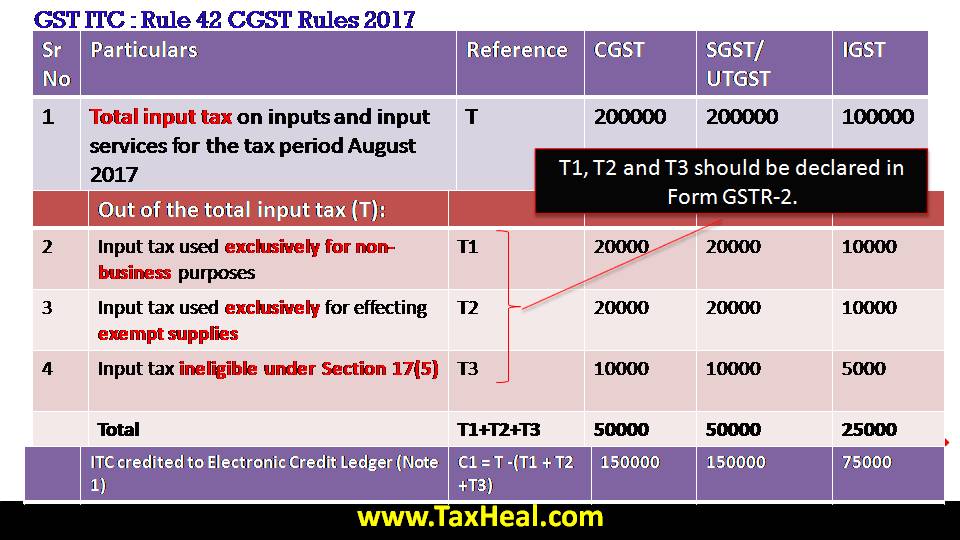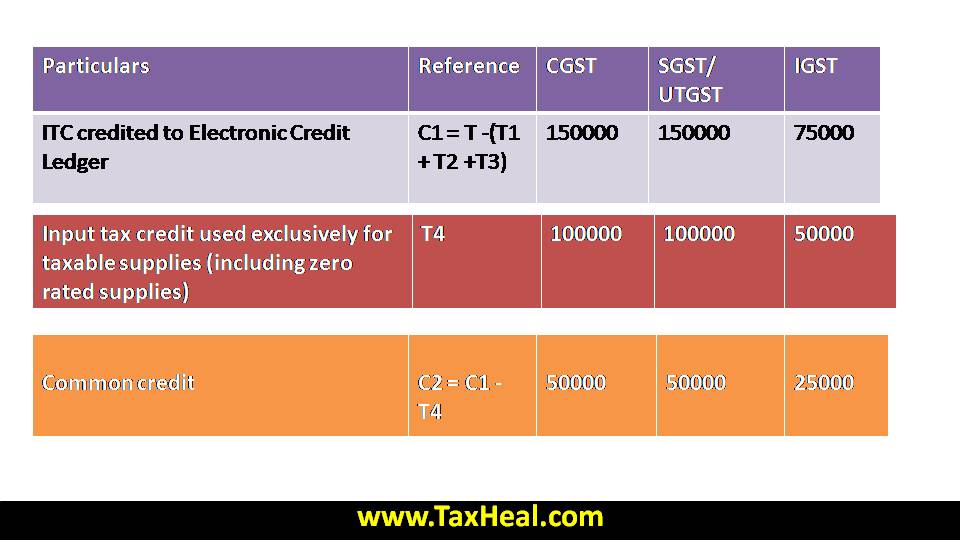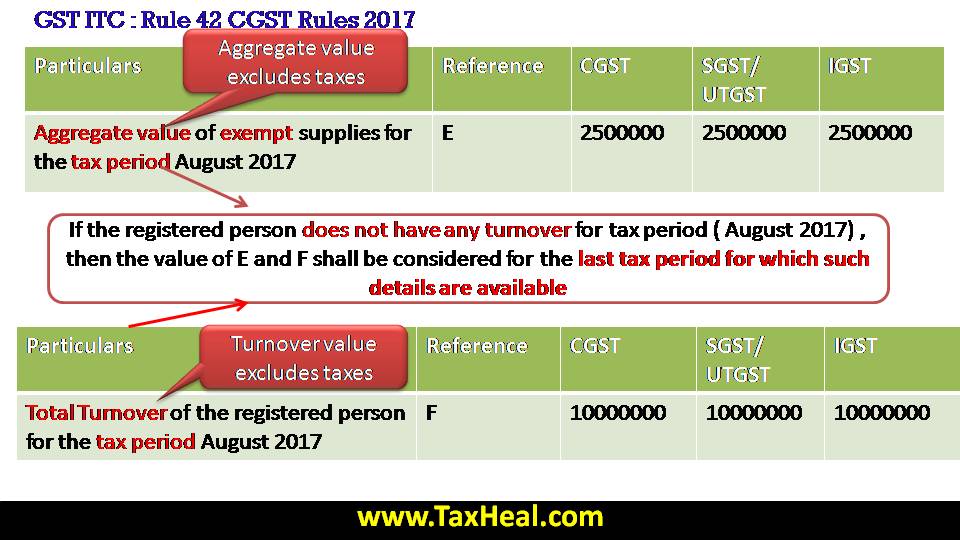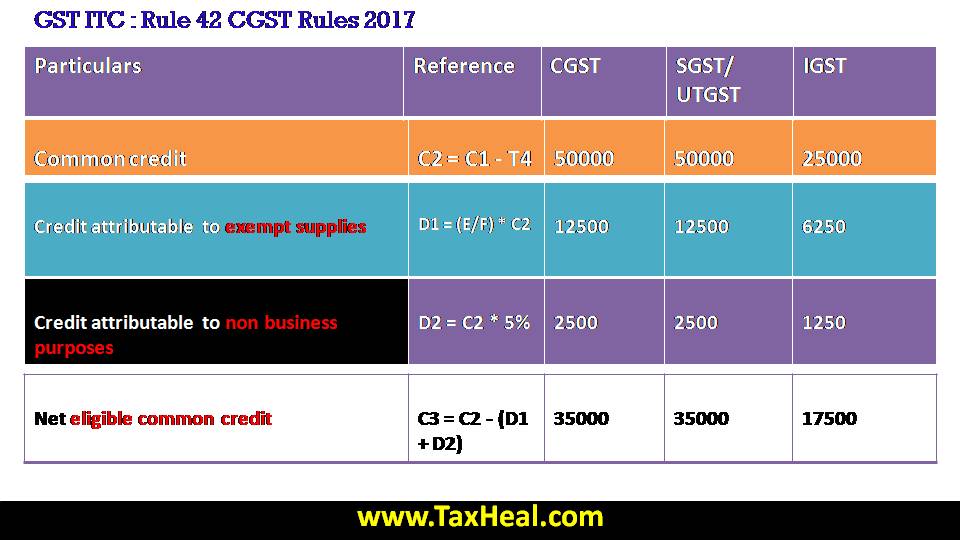Analysis : Rule 42 CGST Rules 2017
Rule 42 CGST Rules 2017 deals with manner of determination of input tax credit in respect of inputs or input services and reversal thereof
1.If Input and Input Services are partly used for the purposes of business and partly for other purposes,
2.If Input and Input Services are partly used for effecting taxable supplies (including zero rated supplies ) and partly for effecting exempt supplies,
Example on Rule 42 CGST Rules 2017
where the amount of input tax relating to inputs or input services used partly for the purposes other than business and partly for effecting exempt supplies has been identified and segregated at the invoice level by the registered person, the same shall be included in ‘T1‘ and ‘T2‘ respectively, and the remaining amount of credit on such inputs or input services shall be included in ‘T4 i.eexclusively for taxable supplies [ Proviso to Rule 42(1) CGST Rules ]
Rule 42 CGST Rules 2017
Manner of determination of input tax credit in respect of inputs or input services and reversal thereof
- (1) The input tax credit in respect of inputs or input services, which attract the provisions of sub-section (1) or sub-section (2) of section 17, being partly used for the purposes of business and partly for other purposes, or partly used for effecting taxable supplies including zero rated supplies and partly for effecting exempt supplies, shall be attributed to the purposes of business or for effecting taxable supplies in the following manner, namely,—
(a) the total input tax involved on inputs and input services in a tax period, be denoted as ‘T’;
(b) the amount of input tax, out of ‘T’, attributable to inputs and input services intended to be used exclusively for the purposes other than business, be denoted as ‘T1‘;
(c) the amount of input tax, out of ‘T‘, attributable to inputs and input services intended to be used exclusively for effecting exempt supplies, be denoted as ‘T2‘;
(d) the amount of input tax, out of ‘T’, in respect of inputs and input services on which credit is not available under sub-section (5) of section 17, be denoted as ‘T3‘;
(e) the amount of input tax credit credited to the electronic credit ledger of registered person, be denoted as ‘C1‘ and calculated as—C1 = T- (T1+T2+T3);
(f) the amount of input tax credit attributable to inputs and input services intended to be used exclusively for effecting supplies other than exempted but including zero rated supplies, be denoted as ‘T4‘;
(g) ‘T1‘, ‘T2‘, ‘T3‘ and ‘T4‘ shall be determined and declared by the registered person at the invoice level in FORM GSTR-2;
(h) input tax credit left after attribution of input tax credit under clause (g) shall be called common credit, be denoted as ‘C2‘ and calculated as C2 = C1 – T4 ;
(i) the amount of input tax credit attributable towards exempt supplies, be denoted as ‘D1‘ and calculated as—D1= (E÷F) × C2
where,
‘E’ is the aggregate value of exempt supplies during the tax period, and
‘F’ is the total turnover in the State of the registered person during the tax period:
Provided that where the registered person does not have any turnover during the said tax period or the aforesaid information is not available, the value of ‘E/F’ shall be calculated by taking values of ‘E’ and ‘F’ of the last tax period for which the details of such turnover are available, previous to the month during which the said value of ‘E/F’ is to be calculated
Explanation : For the purposes of this clause, it is hereby clarified that the aggregate value of exempt supplies and the total turnover shall exclude the amount of any duty or tax levied under entry 84 of List I of the Seventh Schedule to the Constitution and entry 51 and 54 of List II of the said Schedule;
LIST I – UNION LIST : Entry No 84 .Duties of excise on the following goods manufactured or produced in India, namely:—(a) petroleum crude;
(b) high speed diesel;
(c) motor spirit (commonly known as petrol);
(d) natural gas;
(e) aviation turbine fuel; and
(f) tobacco and tobacco products.
LIST I I– STATE LIST : Entry No 51 : Duties of excise on the following goods manufactured or produced in the State and countervailing duties at the same or lower rates on similar goods manufactured or produced elsewhere in India:—
(a) alcoholic liquors for human consumption;
(b) opium, Indian hemp and other narcotic drugs and narcotics, but not including medicinal and toilet preparations containing alcohol or any substance included in sub-paragraph (b) of this entry.
LIST I I– STATE LIST : Entry No 54 : Taxes on the sale of petroleum crude, high speed diesel, motor spirit (commonly known as petrol), natural gas, aviation turbine fuel and alcoholic liquor for human consumption, but not including sale in the course of inter-State trade or commerce or sale in the course of international trade or commerce of such goods.
(j) the amount of credit attributable to non-business purposes if common inputs and input services are used partly for business and partly for non-business purposes, be denoted as ‘D2‘, and shall be equal to five per cent of C2; and
(k) the remainder of the common credit shall be the eligible input tax credit attributed to the purposes of business and for effecting supplies other than exempted supplies but including zero rated supplies and shall be denoted as ‘C3‘, where,—C3 = C2 – (D1+D2);
(l) the amount ‘C3‘ shall be computed separately for input tax credit of central tax, State tax, Union territory tax and integrated tax;
(m) the amount equal to aggregate of ‘D1‘ and ‘D2‘ shall be added to the output tax liability of the registered person
Provided that where the amount of input tax relating to inputs or input services used partly for the purposes other than business and partly for effecting exempt supplies has been identified and segregated at the invoice level by the registered person, the same shall be included in ‘T1‘ and ‘T2‘ respectively, and the remaining amount of credit on such inputs or input services shall be included in ‘T4’.
(2) The input tax credit determined under sub-rule (1) shall be calculated finally for the financial year before the due date for furnishing of the return for the month of September following the end of the financial year to which such credit relates, in the manner specified in the said sub-rule and
(a) where the aggregate of the amounts calculated finally in respect of ‘D1‘ and ‘D2‘ exceeds the aggregate of the amounts determined under sub-rule (1) in respect of ‘D1‘ and ‘D2‘, such excess shall be added to the output tax liability of the registered person in the month not later than the month of September following the end of the financial year to which such credit relates and the said person shall be liable to pay interest on the said excess amount at the rate specified in sub-section (1) of section 50 for the period starting from the first day of April of the succeeding financial year till the date of payment; or
(b) where the aggregate of the amounts determined under sub-rule (1) in respect of ‘D1‘ and ‘D2‘ exceeds the aggregate of the amounts calculated finally in respect of ‘D1‘ and ‘D2‘, such excess amount shall be claimed as credit by the registered person in his return for a month not later than the month of September following the end of the financial year to which such credit relates.
Related Topic on GST
| Topic | Click Link |
| GST Acts | Central GST Act and States GST Acts |
| GST Rules | GST Rules |
| GST Forms | GST Forms |
| GST Rates | GST Rates |
| GST Notifications | GST Act Notifications |
| GST Circulars | GST Circulars |
| GST Judgments | GST Judgments |
| GST Press Release | GST Press Release |
| GST Books | Best Books on GST in India |
| GST Commentary | Topic wise Commentary on GST Act of India |
| GST You Tube Channel | TaxHeal You Tube Channel |
| GST Online Course | Join GST online Course |
| GST History | GST History and Background Material |









